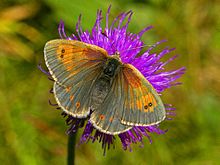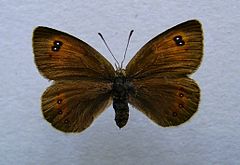| Common brassy ringlet | |
|---|---|

| |
| E. c. arvernensis - female upperside | |

| |
| E. c. arvernensis - underside | |
|
Scientific classification
| |
| Domain: | Eukaryota |
| Kingdom: | Animalia |
| Phylum: | Arthropoda |
| Class: | Insecta |
| Order: | Lepidoptera |
| Family: | Nymphalidae |
| Genus: | Erebia |
| Species: | E. cassioides
|
| Binomial name | |
| Erebia cassioides (Reiner & Hohenwarth, 1792)
| |

| |
| Synonyms | |
| |
Erebia cassioides, the common brassy ringlet, is a member of the subfamily Satyrinae of family Nymphalidae.
Subspecies
Subspecies include: [1]
- Erebia cassioides cassioides – common brassy ringlet
- Erebia cassioides arvernensis Oberthür 1908 - western brassy ringlet [2]
- Erebia cassioides carmenta Fruhstorfer, 1907 - western brassy ringlet [3]
- Erebia cassioides macedonica Buresch, 1918 (Bulgaria)
- Erebia cassioides illyrica Lorkovic, 1953
- Erebia cassioides tonalensis Arnscheid & Roos, 1976
On the basis of studies of enzymatic electrophoresis and of mitochondrial DNA the subspecies Erebia cassioides arvernensis should be considered a distinct species named Erebia dromus (Fabricius, 1793), [4] which is distributed in the western Pyrenees, in the western Alps and in Apennines. [5] [6]
Distribution and habitat
This European endemic species is present in Spain ( Cantabrian mountains, Pyrenees), France (Pyrenees, Massif Central and the western and eastern Alps), Italy, Switzerland, Romania ( Carpathians), Bulgaria (Rila and Pirin Mountains.), Greece, North Macedonia and in the Balkans ( Serbia, Montenegro, Albania and Bosnia). It prefers grassy slopes with stones and rocks at altitudes between 1,600 and 2,600 meters. [7] [8] [9]
Description
The wingspan is 32–38 mm. [10] These small butterflies have a brown forewings with a metallic-greenish shine, the so-called "brassy ringlet". On the forewings there is an orange postdiscal band and two small ocelli pupillated with white towards the apex. A series of small ocelli appears on the hindwings. The underside of the forewings is orange with a brownish border and two small ocelli at the apex, while the hindwings are shiny silvery gray and ocher. [11]
Taxonomy
E. cassioides is a member of the brassy ringlet species complex.
Biology
The females lay their eggs close to the ground, usually on dry stalks of grass. The larvae feed on various grasses ( Festuca ovina, Poa species, Nardus stricta), including Gramineae species. The caterpillar hibernates in the first or second larval instar and pupates the following year between June and August. [7] Adults fly from July to September with a peak in August.
Gallery
-
Upperside
-
Underside
-
Erebia cassioides arvernensis
Bibliography
- Albre (Jérôme), Gers (Charles) & Legal (Luc), 2008. Taxonomic notes on the species of the Erebia tyndarus group (Lepidoptera, Nymphalidae, Satyridae). Lépidoptères- Revue des Lépidoptéristes de France, vol. 17- N°39 : 12 - 28.
- Guide des papillons d'Europe et d'Afrique du Nord de Tom Tolman, Richard Lewington, éditions Delachaux et Niestlé, 1998 - ( ISBN 2-603-01114-6)
- van Swaay, C., Wynhoff, I., Verovnik, R., Wiemers, M., López Munguira, M., Maes, D., Sasic, M., Verstrael, T., Warren, M. & Settele, J. 2010. Erebia cassioides.
References
- ^ "Erebia Dalman, 1816" at Markku Savela's Lepidoptera and Some Other Life Forms
- ^ INPN
- ^ NCBI
- ^ Catalogue of life
- ^ "Acta Plantarum". Archived from the original on 2014-07-09. Retrieved 2017-01-23.
- ^ Inaturalist
- ^ a b IUCN
- ^ Eurobutterflies
- ^ Fauna europaea
- ^ "Butterfly Guide". Archived from the original on 2019-07-22. Retrieved 2017-01-23.
- ^ Jérôme Albre, Charles Gers, Paul Sabatier Taxonomic notes on the species of the Erebia tyndarus group (Lepidoptera, Nymphalidae, Satyrinae)
External links
- Paolo Mazzei, Daniel Morel, Raniero Panfili Moths and Butterflies of Europe and North Africa
- Pyrgus.de


